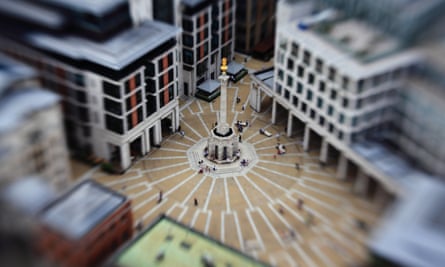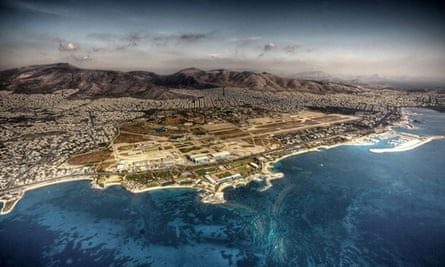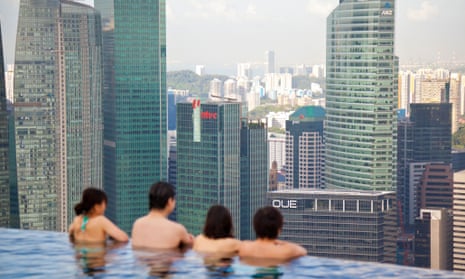“It may well be the case that democracy and capitalism, which at moments in their youth were allies, cannot live together once both have come of age.” So wrote the historian EH Tawney in 1938.
Tawney’s prescient quote could well apply to London today, where the “Boris Boom” is overseeing a version of extreme capitalism that is privatising vast swaths of the capital. Publicity so far has focused on the 250 planned skyscrapers, but at least as important is the fact that all this new development will be privately owned and privately controlled. Nine Elms in South London, for example, an enormous, 195-hectare private estate that will be home to the new ultra-high security American embassy, is typical of this new wave of privatisation. So is London’s Olympic Park, which is private in as much as all the new communities within it, such as the Olympic Village, are also privately owned.
But does this mean that London – boosted by the receipts of quantitative easing, a lax tax regime and foreign oligarch money – is becoming the most private city in the world?
It is notoriously difficult to quantify and map the privatisation of space and place. Dubai, which must lay claim to being one of the most privatised cities in the world, is defined by its newness – and it is this newness which is generally an indicator of how private a place is likely to be. This is because today’s dominant economic model is reflected by high-security, privatised plazas which house shopping areas, conference centres and luxury apartments in an environment less reminiscent of the public realm than an airport lounge.

The ancient Greek word idiotes means somebody who does not participate in public life. In ancient Greece, private life was confined to the home; the public, democratic life of citizens took place in the polis or city, and in the agora or assembly. The contemporary gated community, which focuses on privatising the experience of home as much as possible, fits well within this classical definition of private. There are literally millions of people living in gated communities: they have become the model of choice in the many societies around the world that are subject to extreme wealth inequalities.
In City of Quartz, his seminal 1990s study of Los Angeles, Mike Davis painted a dystopian picture of a high-security city: privatised enclaves and gated developments policed by armed guards. Such gated communities flourish in particularly polarised, segregated societies such as LA, which is one of the most ethnically and socially divided cities in the US.
Gating, like all aspects of privatisation, is difficult to map. The American Housing Survey estimated that almost 11 million Americans live in gated communities, a figure many believe is much higher. Most gated communities are found in the sun-belt states: California, Florida and Texas.
A number of these communities in the US have incorporated as separate entities, entirely independent from local government, meaning that they do not pay taxes and that all services, from rubbish collection to policing, are privately provided.

Gated communities are a global phenomenon, and India – whose new city of Lavassa is to be one of the first entirely private cities on the subcontinent – is typical of the many countries with huge wealth inequalities. Many millions of Indians live behind gates, as they do in Latin America, parts of Africa and the Middle East, Russia and parts of Asia, particularly China. It is Mexico that is estimated to have the largest number of gated communities in the world, with close to 57 million people living behind them. In Rio, inhabitants of armed, gated compounds commute by helicopter to avoid the streets and barrios of the city. In South Africa, post apartheid reconciliation has done little to dispel fear between communities, with cities like Johannesburg among the most heavily securitised and private in the world.
Nor is Britain immune: a government-commissioned report in 2003 found at least 1,000 gated communities, a figure that is certain to be far higher today; every town and city centre is also now host to a number of privately owned estates, such as Cabot Circus in Bristol, or Liverpool One, which spans 34 streets in the heart of the city.
If LA was the emblematic postmodern city for the 1990s, that crown soon passed to Dubai, thanks to a property boom that witnessed a series of superlatives, from tallest building to largest artificially created islands, and went hand in hand with the roll-out of private space: those artificial islands are set to add 520km of non-public beaches. As Dubai grew, disturbing reports emerged of terrible conditions endured by construction workers.
But it is not only booms that drive urban privatisation. Hellinikon in Athens, a 620-hectare scheme that dwarfs Nine Elms is set to be one of the biggest privatisation projects Europe has ever seen: the site of Greece’s former airport will morph into a casino and leisure complex that will apparently resemble Singapore’s Marina Bay Sands.

How is it that Greece, the country hit hardest by the financial crisis, is embarking on one of Europe’s biggest ever private developments? In fact, it is precisely the scale of the Greek crisis that paved the way for the plans: Europe’s institutions enforced a highly controversial privatisation programme, since abandoned by Greece’s new leftwing government – but not before this enormous development was given the green light.
In The Shock Doctrine, Naomi Klein writes of “disaster capitalism”, whereby the aftermath of economic and political crisis is seen as the perfect opportunity for the roll-out of extreme neo-liberal policies. Greece is a perfect example.
In general, the privatisation of public space in the west accompanied the traumatic transition from an industrial economy to one based on financial services, shopping, entertainment and “knowledge”. This model began in 1970s America, where downtown waterfront areas that were former industrial heartlands were redeveloped into entertainment complexes: Baltimore’s Inner Harbour, described by the Urban Land Institute as “the model for post-industrial waterfront redevelopment”, is the prime example.
London’s Docklands, once the hub of the UK’s shipbuilding industry, became a centre for privatised financial services districts such as Canary Wharf, gated developments and private campuses such as the Excel, the enormous conference centre where the potential to “lock down” the site ensures it is well suited to host such events as the Defence and Security Equipment International Exhibition.
War very often leads to heavily privatised areas, too. In downtown Beirut, the rebuilding of the city centre provided the opportunity for Rafik Hariri, a billionaire businessman and the former prime minister, to form Solidere, a company that has remodelled a 200-hectare area of the city centre.
Jerold S Kayden at Harvard has coined the term Pops (“privately owned public space”) for these types of places, and found that there are 503 in New York City alone. One of the highest profile is Manhattan’s latest tourist attraction, the High Line, which also appears to be the model for London’s contentious Garden Bridge – an urban “park” that bans all sorts of activities, closes for corporate events, does not allow political protest and requires groups of more than eight people to book ahead.
Indeed, the key question in determining how “private” a city might be could be about access, rather than ownership. Zucotti Park, another Pops in New York, was for many months the venue for the Occupy Wall Street protests. Contrast that with London’s Paternoster Square, home to the London Stock Exchange, where Occupy was quickly evicted when the owners took out an injunction. Political activity has been almost entirely squeezed out of London’s square mile, and Occupy had no choice but to camp outside St Paul’s Cathedral, on the only genuinely public space left in the city.
So while it may be impossible to name a city or a place as the “most private” in the world, what we can say is that societies with high levels of inequality are also those where the privatisation of the public realm and life behind gates increasingly defines the urban fabric. In Britain and North America, where democracy remains the system by which we define ourselves, the spread of this kind of city space is extremely problematic, as it suggests that Tawney was right. While our leaders preach democracy, the increasingly private architecture of our cities is telling a more honest story.
Anna Minton is the author of Ground Control and leads the new University of East London MRes course Reading the Neoliberal City.

Comments (…)
Sign in or create your Guardian account to join the discussion